|















©
1999-2025
Man From Mars Productions

|
| |
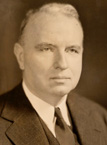 |
Unique among
radio stations, WDRC has had only four owners during its
entire history.
Okay--FCC files
list more than two corporate entities, but the fact remains
that WDRC was founded in 1922 by Franklin Malcolm Doolittle
who headed it until August 4, 1959 when the station was sold to
Buckley-Jaeger Broadcasting Corporation of Connecticut. John Jaeger
later sold his shares to Richard D. Buckley whose son, Richard
D. Buckley, Jr., headed the family corporation until his death
on July 31, 2011. On July 7, 2014 WDRC FM/AM (and WWCO, WSNG
and WMMW) were bought by Connoisseur
Media. On January 15, 2018 Connoisseur sold WDRC AM/FM in Hartford,
WSNG Torrington, and WMMW Meriden to Red
Wolf Broadcasting.
Doolittle's
career and influence were remarkable - a true broadcast pioneer,
especially in the development of Frequency Modulation (FM). The
webmaster gratefully acknowledges the contributions from Mr. Doolittle's
son, John.
|
|
| |
 |
June
16, 1893
- Franklin Malcolm Doolittle was born in New Haven, Connecticut,
the son of Frank M. Doolittle & Nellie C. Beecher.
1905
- Lee DeForest, "the father of modern radio," built
New Haven's first wireless transmitter at City Point. Eleven-year-old
Franklin M. Doolittle used to go there to test his homemade
receiver and spark-coil transmitter.
|
|
A 1906
newspaper article about the budding scientist described Doolittle
as "a rosy cheeked schoolboy" while reporting
that "other schoolboys cannot quite enter into sympathy
with him, because they do not understand what he does and
thinks out." Click for the full text of the article
here.
1909-1915
- During school vacations, Doolittle worked as a shipboard
radio operator for the United Wireless Telegraph Company and
American Marconi Company.click
for enlargement | click
for service record
|
 |
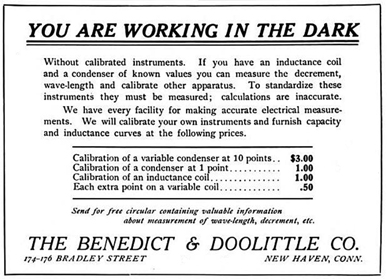 |
1912
- Doolittle joined the Institute of Radio Engineers.
1913
- The March issue of Electrician & Mechanic magazine
contained an advertisement (left) for Doolittle's first commercial
enterprise. He and an unknown partner named Benedict sold
electronic measuring services from the Doolittle family home
on Bradley Street in New Haven.
|
 |
1917
- When World War I erupted, Doolittle attended the U.S. Naval
Academy at Annapolis, MD, and received a temporary commission
to serve on the battleship New Mexico. He served as communications
officer of the Fourth Squadron, Battleship Force 11 and at the
District Communications Office in New York City. |
|
1919
- He started a small radio manufacturing business at 917 Chapel
Street in New Haven called Franklin M. Doolittle Company,
later incorporated as Doolittle Radio Corporation.
He built and sold radio receivers for $250-$300 (see photo
below).

click
for more on the Doolittle Tuner
| Duplex Gap | Audimax
| Amplifone | Decremeter
| Decremeter 2
1919-25
- He taught at Yale's Sheffield Scientific School, assisting
in undergraduate instruction and postgraduate instruction
of officers assigned to the Signal Corps.
|
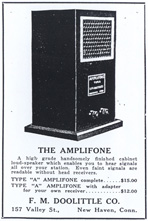 |
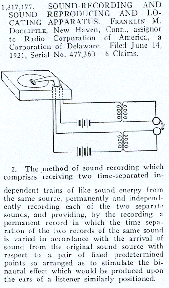 |
February
13, 1920 - The Department of Commerce Bureau of
Navigation issued Doolittle a license for General Amateur
radio station 1GAI. He was authorized to broadcast
from 167 Willard Street in New Haven with 1kw of power on
200 meters.
June
14, 1921
- Doolittle sold his federal patent application for "Sound
Recording and Sound Reproducing and Locating Apparatus"
to Radio Corporation of America (Serial #477,360).
click on image for enlargement
| November
12, 1921 - Doolittle broadcast the first football
game -Yale vs. Princeton - over his amateur radio station,
1GAI. New Haven Register sports editor Dan
Mulvey attended the game and described the play over a
telephone to Doolittle who was at home with his transmitter.
Doolittle repeated the information into his homemade microphone. |
|
 |
Click
for newspaper announcement | Click
for fan mail
|
|
November
27, 1922 - Doolittle Radio Corporation applied
for a federal license for a "limited commercial land
radio station" based at 817 Chapel Street in New
Haven. Click here to see first
license.
December
10, 1922 - Above a shop at 115 Crown Street in
New Haven, Connecticut's first commercial radio station was
born: 10-watt WPAJ (360 meters/833 kilocycles). In
cramped quarters, Doolittle worked with engineer Italo A.
Martino and partner, Walter B. Haase. Doolittle was President
& Treasurer.
|
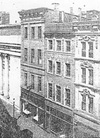 |
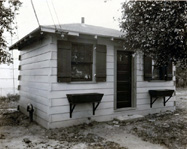 |
March
13, 1923 - Since U.S. Commerce Department radio
licenses were only good for three months, WPAJ filed
for renewal. It specified its Beacon Hill antenna system was
"T-type" consisting of two 110-foot wooden masts
with a 105-foot horizontal part and 35-foot vertical part
described as "4 wire flat top 13' spreaders."
For an electrical ground, this mechanism was clamped to a
steam pipe.
Click
on photo for enlargement
|
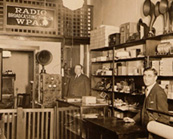 |
1923
- The station shared a storefront on Chapel Street where Doolittle
sold his line of equipment, including radio receivers. Doolittle
sets sold for $250 to $300.
Click
on photos for enlargements
|
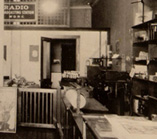 |
|
|
|















